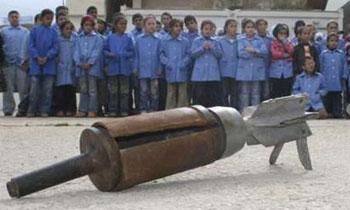|
|
Environment
Iraq Territories Contaminated with Land Mines
Thursday, March 29, 2012

Cairo- (PanOrient News) The Ministry of Environment in Baghdad said that 30% of Iraqi territory is contaminated with mines and surveys are being conducted for their removal through cooperation programs between Iraq and the United Nations.
The work is expected to take about 10 years, the ministry said, adding that Iraq needs about 19,000 mine removers to eliminate all mines planted in its territories.
In 2007, Iraq joined the Ottawa Treaty to locate and clear mines and unexploded projectiles by 2018, but the task is anything but easy.
Land mines were planted in Iraq in the sixties of the last century by various governments that fought Kurdish rebels who called for independence in the north. Later on, border skirmishes between Iraq and Iran in 1969 pushed Iraqi governments to plant more mines along the borders.
The number of mines planted in Iraq reached millions at the time of Iran-Iraq war between 1980 and 1988. The number of these silent killers increased significantly in Iraq in a way that has never been seen in the history of wars, Iraqi officials said.
Borders shared with Iran, turned to a giant minefield hosting millions of various types of mines. Over 1,270 km long, and a depth range from 5 km to 15 km stretching from the shores of Fao to the Turkish-Iran-Iraq border, millions of mines continue to cause death and injury to civilians.
Confrontation with the United States, and a war looming on the horizon lead to more mines being planted in the year of 2003 right before the invasion of Iraq by an international coalition led the United States.
The war has ended, but these silent killers still number over 20 million spread over 1,730 million square meters of Iraqi land. With the fall of Iraqi President, Saddam Hussein, observers hope that the last chapter of mine pollution has ended.
A survey by Iraqi and UN related organizations suggested there are some 4,000 areas in 13 prefectures out of 18 in Iraq that are described as being "very dangerous mine fields".
Human damage has been huge. Various statistics put the number of local people disabled by mines in Iraq at 244,659 victims, including 172,765 males and 71,894 females of all ages.
The main problem facing mine removal is a lack of mine fields' maps. "Most available maps are inaccurate" said an Iraqi expert to local media. "The disappearance of minefield' landmarks is another problem. They have been washed away or buried because of rain, floods and theft of field fences" he added.
Most of the buried mines are manufactured from plastic materials, and having them relatively deep under the ground makes detection and identification a difficult task, experts said.
The lack of security in some regions, and the limited numbers of specialists in mine clearance, make the problem even more difficult. The most common mine is the anti-personal Italian mine vs50, and Valmara 69.
PanOrient News
© PanOrient News All Rights Reserved.
|
|

